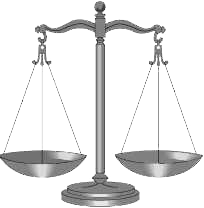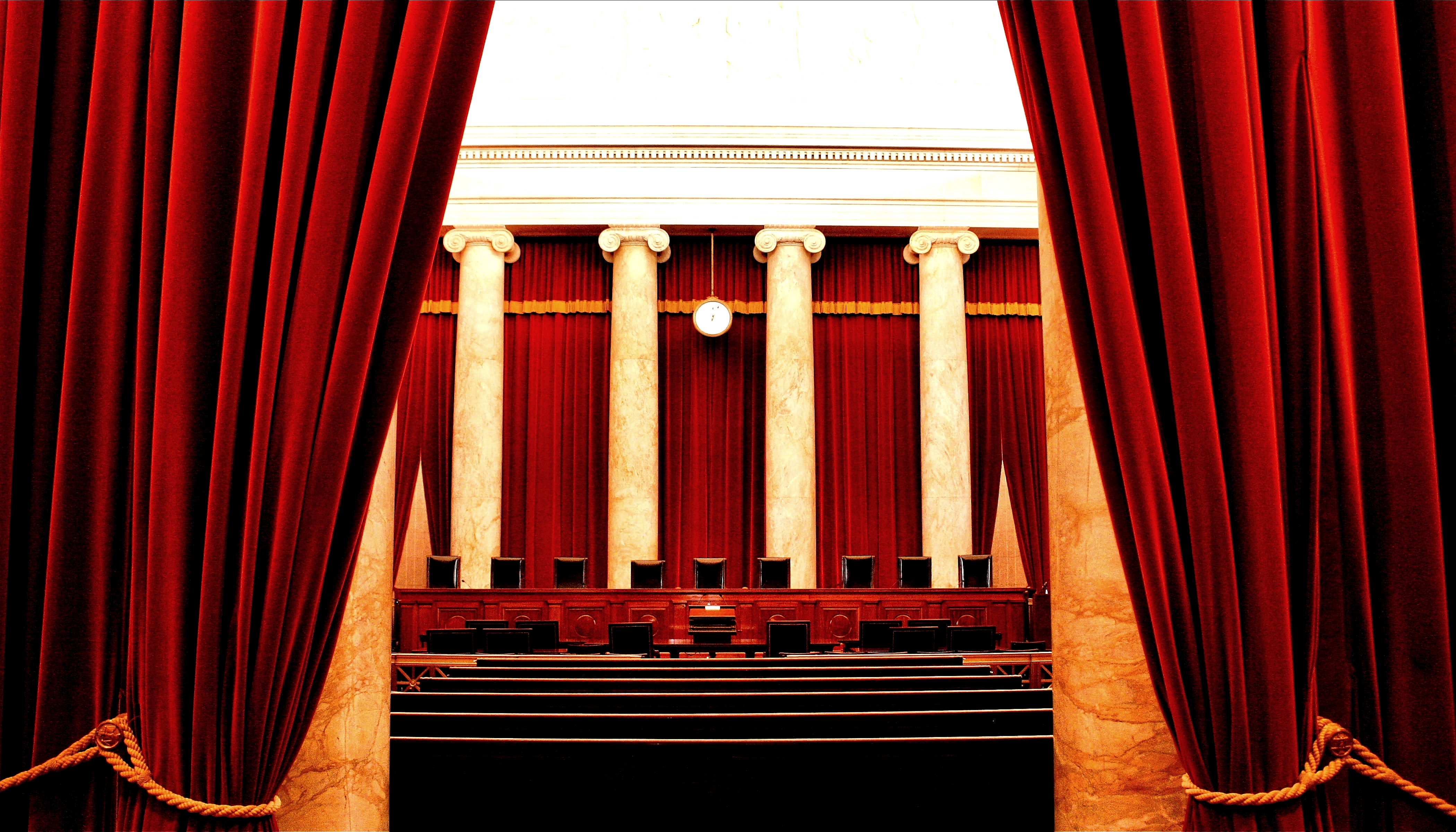
Focus Questions
-
What are the functions of courts?
-
What are the principles of judicial review and an independent Judiciary?
For an overview, see the official US Courts.gov homepage:
Topics on the Page
The Principle of Judicial Review
The Supreme Court
- Women Supreme Court Justices
- Louis Brandeis
- Thurgood Marshall
United States Court of Appeals
United States District Courts
Bankruptcy Courts
Courts in Massachusetts
Digital Games for Learning about Courts
- Supreme Court Justice Dogs Videos
Judicial Review
- Refers to the power of the courts to determine the constitutionality of a law.
- This power of the courts came into effect after the court case Marbury V. Madison in 1803. In this case the Supreme court decided that the court had the power to nullify laws created by States or Congress if they did not abide by the Constitution.
- For additional Judicial Review info click here.
 Click here for a judicial review lesson plan
Click here for a judicial review lesson plan
 |
| "Guardian of Law" by James Earle Fraser, US Supreme Court |
Functions of the Courts in the United States
The United States federal court system is made up of four different types of courts.
- United States Supreme Court
- District courts
- United States Courts of Appeals
- Bankruptcy Court.
For more information, view the following lesson plan from icivics.og: Lesson plan on the Judicial Branch
View the following video Crash Course by PBS on the structure of the Supreme Court
The Supreme Court

The major federal court of the country is the Supreme Court. They have the final decision of difficult court cases that lower courts couldn't decide. The Supreme Court is where the law has the most potential to change.
The Supreme Court is made up of the Chief Justice of the United States and eight associate justices.
- This court hears between 70 and 80 cases each year and they usually involve issues and questions about the Constitution or federal law.
-
- The Supreme Court has to follow strict guidelines established by Congress when hearing cases
Who decides how many Justices are on the Court? Have there always been nine?
The Constitution places the power to determine the number of Justices in the hands of Congress.
- The first Judiciary Act, passed in 1789, set the number of Justices at six, one Chief Justice and five Associates.
- Over the years Congress has passed various acts to change this number, fluctuating from a low of five to a high of ten.
- The Judiciary Act of 1869 fixed the number of Justices at nine and no subsequent change to the number of Justices has occurred.

John Jay was first Chief Justice of the Supreme Court. Painting by Gilbert Stuart, 1795
 Play the following game to find out How Do Your Views Align with the Current Supreme Court Justices?
Play the following game to find out How Do Your Views Align with the Current Supreme Court Justices?
Click here for more information on the Supreme Court from the University of Missouri/Kansas City. See also the series The Supreme Court from PBS.
25 Landmark Cases in Supreme Court History
How Current Supreme Court Justices Compare with Predecessors
Click here to see the Martin-Quinn Scores, an overview of the ideological positions of Supreme Court justice since 1937 in a website created by faculty members at the University of California Berkeley School of Law.

As reported in the New York Times (July 25, 2010), Harold J. Spaeth. a professor at Michigan State University, has coded Supreme Court rulings since 1937 as conservative or liberal.
- The most liberal justices between 1937 and 2009 were Thurgood Marshall (21% conservative votes) and William O. Douglas
- The most conservative were Clarence Thomas (82% conservative votes) and William Rehnquist.
- According to this measure, four of the most conservative justices since the 1930s are currently serving on the Court (Thomas, Samuel Alito, Antonin Scalia and John Roberts). Scalia has since been replaced by Neil Gorsuch.
Study Challenges Supreme Court's Image as Defender of Free Speech examines the Roberts Court record on First Amendment cases. It contends that the Roberts Court is ruling in favor of free speech at a lower rate than the three previous courts under Chief Justices Rehnquist, Burger, and Warren.
Click for an interactive timeline of all United States Supreme Court Justices here
Click here for a video that explains how Supreme Court judges are appointed
 Click here to learn about how the Court voted to legalize same sex marriage nationwide
Click here to learn about how the Court voted to legalize same sex marriage nationwide
Women Supreme Court Justices
 Videos – The Four Justices Series by the National Portrait Gallery
Videos – The Four Justices Series by the National Portrait Gallery
Sonia Sotomayor
Sandra Day O'Connor
Ruth Bader Ginsberg
Elena Kagan
(Teachers could separate the group into four groups and give each group one video to watch and share facts on.)
 |
| Ruth Bader Ginsburg |
Click here for a biography of Ruth Bader Ginsburg.
I Dissent: Ruth Bader Ginsburg Makes Her Mark is the first picture book about her life.
Biography on Sandra Day O'Connor, the first female Supreme Court Justice
 |
| Sandra Day O'Connor |
Sandra Day O'Connor. See her entry in Influential Women in American History
Ruth Bader Ginsburg. See her entry in Influential Women in American History
Sonia Sotomayor
In 2009, President Barack Obama nominated Sonya Sotomayor as the 111th Supreme Court Justice.
-
She is the court's first Hispanic and third female justice.
-
In 2010, she predicted that "nation's high court likely would be asked again to weigh issues of national security versus free speech because of the recently leaked classified war documents posted on the WikiLeaks website."
For a perspective on the background on the first Hispanic American to serve on the Court, see reviews on GoodReads of the book Sonia Sotomayor: A Judge Grows in the Bronx.
Elena Kagan
In 2010, President Barack Obama nominated Elena Kagan as the 112 Supreme Court Justice. Kagan is a First Amendment Scholar who has written several journal articles on the free speech right.
Click here for a NYT article about Justice Kagan
President Obama nominates Elena Kagan to the Supreme Court, May 2010.
Louis Brandeis
 |
| Louis Brandeis |
The First Jewish Supreme Court Justice 1916, advocated for privacy rights of citizens and upheld freedom of expression laws. More info click for biography.

Thurgood Marshall
 |
| Thurgood Marshall, 1976 |
Biography on Thurgood Marshall
Thurgood Marshall was the first African American Supreme Court justice. Click here for a brief biography. See also the following overview of Marshall's life from Arlington National Cemetery.
Click here to learn how Thurgood Marshall and his associates won the Brown v. Board of Education case. Click here to learn more about Brown v. Board of Education.
Lincoln Statue, Washington D.C. Court of Appeals. Photo by Matthew G. Bisanz

Before cases reach the Supreme Court they must make their way through the other courts in the US. The US court of appeals hears cases involving patent laws and financial situations.
The 94 U.S. judicial districts are organized into 12 regional circuits, each of which has a United States court of appeals. Appeals are formal requests for change in an official decision usually made by defense attorneys to lessen the punishment of their clients.
The Gavel Gap
Examining the Demographic Compositions of U.S. Circuit and District Courts (2020)
- Female judges make up just 27 percent of all lower federal court sitting judges and 34 percent of active judges.
- For their part, women of color comprise just 7 percent of all sitting judges and 10 percent of all active judges serving on the lower federal courts.
US district courts take all matters of law and is the starting place of any case criminal or civil. The district courts are the trial courts in the federal system and can hear any case but within limits set by Congress and the Constitution.
There are 94 federal judicial districts, including at least one district in each state, the District of Columbia and Puerto Rico. District courts are the local courts in cities and towns all over America.
Every day across the country hundreds of people are selected for jury duty which take place in district courts. People have to report to jury duty because it is an important part of the legal system. Citizens of the US have the right to a jury trial. If people disregard jury duty they can be brought into court and even jailed because it is illegal to miss jury duty.
Bankruptcy court is actually part of the federal courts.
The federal courts hear bankruptcy cases in each of the 94 jurisdictions across the country. Bankruptcy laws help people who can no longer pay their creditors. These courts help people get a fresh start by liquidating their assets to pay their debts, or by creating a repayment plan.
Bankruptcy laws also protect and help troubled businesses through similar means. These procedures are covered under Title 11 of the United States Code (the Bankruptcy Code).
Click here to learn more about bankruptcy.
Click here to learn how court cases reach the Supreme Court through this lesson plan.
 Courts of the Commonwealth of Massachusetts
Courts of the Commonwealth of Massachusetts
State courts like the ones in Massachusetts are set up like federal courts but have different laws depending on the state. Massachusetts has district courts, a supreme court, bankruptcy courts and appeals courts.
- Click here to learn more about Massachusetts state courts.
Digital Games for Learning about Law and the Courts
Former Supreme Court Justice Sandra Day O’Connor has been a leader of iCivics, free web-based games that teach schoolchildren learn about how courts and the law function in a democratic society. “Do I Have a Right” and “Supreme Decision” (the first games on the site released in fall 2009) are geared for middle school students.
- "Do I Have a Right” places student game players as members of a law firm that advise clients about what amendment to the constitution applies to problems presented by individuals who walk into their law office.
- "Supreme Decision” asks students to serve as a law clerk for a justice who must write an opinion in First Amendment case that where a school district seeks to ban students from wearing music band T-shirts.
Here's a fun article about Teen Jury, a website about the Supreme Court created by two middle school students.

 Supreme Court Justice Dogs Videos
Supreme Court Justice Dogs Videos
Cameras aren’t allowed in the Supreme Court.
Last Week Tonight with John Oliver fixed that problem with real animals and fake paws.
Feel free to take our footage (https://www.youtube.com/watch?v=tug71...) and reenact cases on your own. Tag them with #RealAnimalsFakePaws so we can find them
Here's the supreme court justice dogs footage: https://drive.google.com/file/d/0B-qDiTIy6ZK5S2NkZGM0Z3pYSU0/view?usp=sharing
And the short video from John Oliver about the making of it: https://www.youtube.com/watch?v=fJ9prhPV2PI
And an example, link to Supreme Court Dogs debate about Social Media in Schools: https://drive.google.com/file/d/1vKuLZPQsUtU-AvXrpUcnb-LXvNTp_Xpu/view?usp=sharing
Click here for a news clip about why cameras are not allowed in the Supreme Court.
Comments (0)
You don't have permission to comment on this page.